Traveling with your Labrador
A road trip with your Lab can either be a nightmare (for you and for them) unless you take these things into consideration for your trip.
On the rare occasion that I travel with my Labradors (most of mine like to stay home—but some love to travel!) I have a list of things I always pack for them.
1. Food and BOTTLED water. (Your pet will have GI issues if you don’t use bottled water—kind of like when we travel to Mexico and drink the water!) You don’t want to be cleaning up a “blow out” in the crate or on the car seat! Be sure to have a collapsible bowl that travels and packs easy like this one: 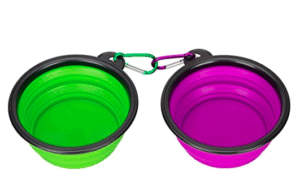
2. His bed. Have a familiar item like a bed or crate to help him feel more comfortable while in NON-familiar spaces. This type of bed is very lightweight, works more as a “crate liner” (so your dog won’t slip around when you go around corners) and you can take it out of the crate and use as a bed once you reach your destination. PLUS this is my dog’s favorite bed, and it can be washed over and over:
3. Keep the routine you have at home—again, it reduces stress.
4. Paper towels and baby wipes for any possible mess, and an extra bed “just in case.”
5. Health records and any medicines you may need while you are away. When traveling from state to state or out of the country be sure to always carry your rabies certificate. Always put a peg tag on your pet too!! Some children’s ‘Immodium’ for your fur baby would be a wise thing to bring. Sometimes they can get stress diarrhea. Or bring some canned pumpkin to use if she gets the “runs.” (add about 1/4 cup with each day’s feeding)
6. A strap or restraint. Remember, dogs can get thrown around or ejected from cars. Never allow your dog to put its head out of the window unless they are restrained properly. See our recommended restraint here.
Here’s the one that is in the link above. We don’t recommend just putting them in a “basket” or “sling” but an actual restraint. This one is specifically for large dogs and is very comfortable:
7. Take some herbal calming tablets (see below) or essential oils for pets that get stressed during travel
For GREAT prices on pet-friendly hotels that BEAT PRICE LINE.
Below are the AKC’s recommendations for traveling with your pet:
TRAVELING WITH YOUR DOG: HEALTH AND SAFETY
• Make sure all his vaccinations are up to date; shot records with you. Health certifications are required for airline travel.
• To keep your dog healthy as you travel, bring along a supply of his regular food and some local, or bottled, water. Be sure to bring any medications he needs.
CRATES
A crate is an excellent way to keep your dog safe in the car, and is required for airline travel. It can also keep your pet from getting into trouble in a hotel or at your host’s home. Crates are available from most pet supply stores. Look for these features when purchasing:
• Large enough to allow the dog to stand, turn and lie down.
• Strong, with handles and grips, and free of interior protrusions.
• Leak-proof bottom covered with absorbent material.
• Ventilation on opposing sides, with exterior rims or knobs to prevent blocked airflow.
• “Live Animal” label, arrows upright, with owner’s name, address and phone number.
• Stock the crate with a comfortable mat, your dog’s favorite toy, and a water bottle, and your dog is ready to go.
We love this soft-sided crate for traveling with a large dog if they are traveling with you in the car. It easily folds away, or moves easy into hotel rooms or tents.
If you are traveling by air and your pet can fit under the seat and is under 25 lbs, this is the perfect soft sided carrier that can fit under your seat in the cabin.
IDENTIFICATION
In the event that your dog gets away from you on your trip, you can increase the chances of recovery by making sure he can be properly identified:
• Make sure your dog has a sturdy leash and collar. The collar should have identification tags with the dog’s name, your name, and your home phone number, as well as proof of rabies shots.
• Consider a permanent form of identification, such as a microchip (see AKC Reunite).
• Bring a recent picture of your dog along with you.
TRAVELING BY CAR
• Get your dog used to the car by letting him sit in it with you without leaving the driveway, and then going for short rides.
• Avoid car sickness by letting your dog travel on an empty stomach. However, make sure he has plenty of water at all times. (use the herbal calming tablets above to PREVENT travel sickness and stress) Give 1 hour prior to travel, then readminister every 4-6 hours.
• Keep the car well-ventilated. If the dog is in a crate, make sure that fresh air can flow into the crate.
• Do not let your dog ride with his head sticking out of an open window. This can lead to eye injuries.
• Never let your dog ride in the back of an open truck. This is extremely dangerous and can lead to severe injuries or death.
• Stop frequently for exercise and potty breaks. Be sure to clean up after your dog. A handy, collapsible exercise pen is PERECT for roadside potty breaks–its secure, and you don’t have to walk 1/2 a mile until the finally decide to “get their business done!” We travel with this one.
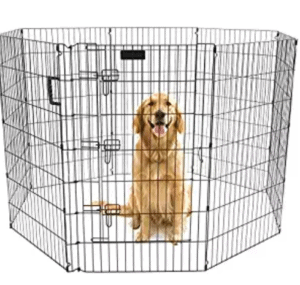 (if you order two you can create a nice little temporary small yard on the side of the road!)
(if you order two you can create a nice little temporary small yard on the side of the road!)
• Car rides are boring for everyone, so instruct your children not to tease or annoy the dog in the car. Be sure the rear ventilation is working properly if you pet is not sitting in the front seat.
• Never, ever leave your dog unattended in a closed vehicle, particularly in the summer. If you must leave the car, designate a member of the family to stay with the dog. Consider getting a CGC certificate for your dog so you can take him anywhere you go. Information on obtaining a Canine Good Citizen certificate can be found a www.akc.com
BY PLANE
• Each airline has its own set of rules for canine air travel. You should call for information and make arrangements well in advance of your trip.
• All airlines require health certifications and proof of vaccinations.
• Some airlines will not transport animals when it is extremely hot or cold.
• Dogs must be in an airline-approved crate when transported as cargo. Small dogs may ride under the seat in a crate or carrier (see above).
BY TRAIN, BUS, AND BOAT
If you plan to travel by train or bus, you may be disappointed. Dogs are not permitted on Amtrak trains or on buses operated by Greyhound and other interstate bus companies. (Service dogs are permitted.) Local rail and bus companies have their own policies.
You may fare better if you’re taking a cruise. The QE2 luxury cruiser, which sails from New York to England/France, provides special lodging and free meals for your dog. However, you should check the policies of the cruise line or ship you will be traveling on before making plans to take your dog on a cruise with you.
LODGING
• Find out in advance which hotels or motels at your destination or on your route allow dogs. Many do not, or have size or breed restrictions. Holiday Inn’s “generally” take pets–but some require a deposit.
• If your dog is allowed to stay at a hotel, respect other guests, staff, and the property.
• Do not leave the dog unattended in a car overnight. Many dogs will bark or destroy property if left alone in a strange place.
• Ask the management where you should walk your dog, and pick up after him. Do not leave any mess behind.
• Remember that one bad experience with a dog guest may prompt the hotel management to refuse to allow any dogs. Be considerate of others and leave your room and the grounds in good condition.
http://www.akc.org/dog-owners/responsible-dog-ownership/travel-tips/



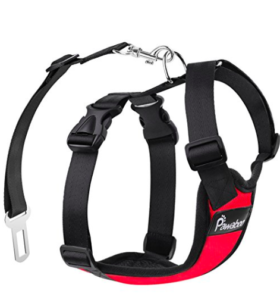
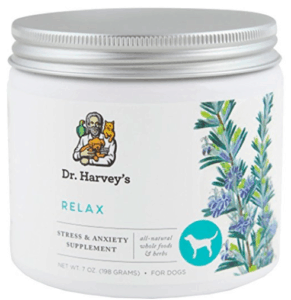
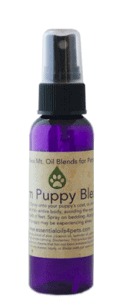

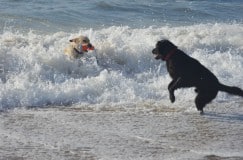

6 Comments